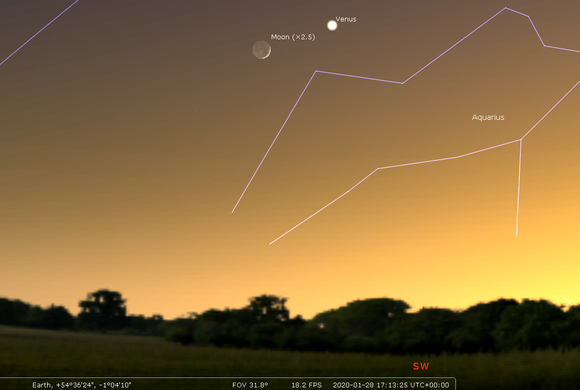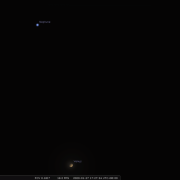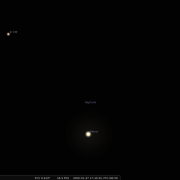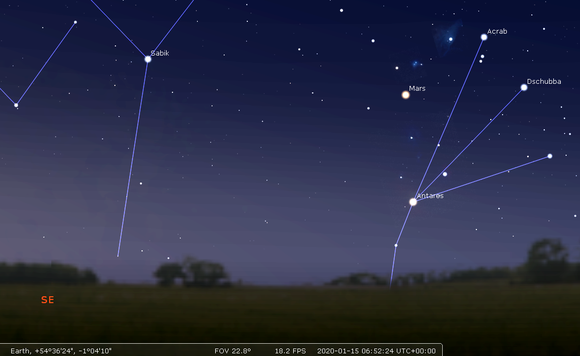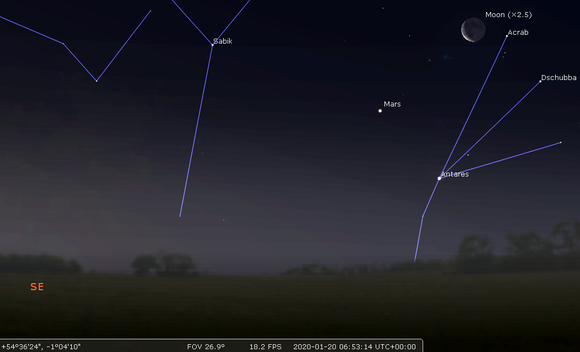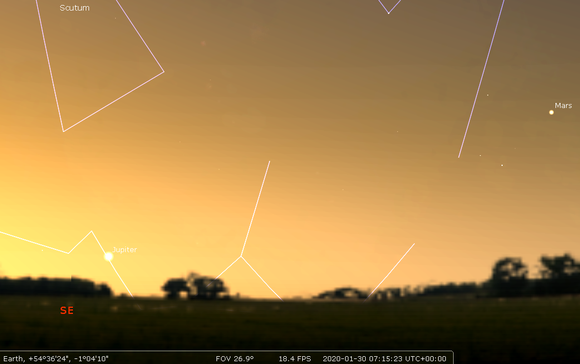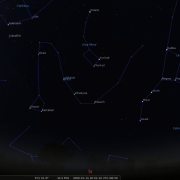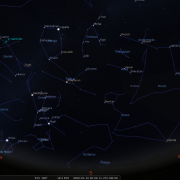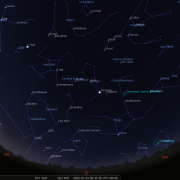In this month's Sky Notes:
- Planetary Skylights
- Meteors
- Penumbral Lunar Eclipse
- Earth reaches Perihelion
- January 2020 Sky Charts
Planetary Skylights
The New Year commences with just two naked eye planets visible, Venus in the evening twilight sky and Mars in the dawn sky.
 Venus is gradually drawing away from the SW horizon growing in presence as it does so and dominating the early evening sky. Through a telescope Venus exhibits a phase, which throughout January will be a waning gibbous. Other than that there is little to see, the now permanent duvet of cloud blanketing the planet, hiding the surface from scrutiny.
Venus is gradually drawing away from the SW horizon growing in presence as it does so and dominating the early evening sky. Through a telescope Venus exhibits a phase, which throughout January will be a waning gibbous. Other than that there is little to see, the now permanent duvet of cloud blanketing the planet, hiding the surface from scrutiny.

 If conditions are clear on the 27th, aim your telescope (low/medium power) towards Venus around 05:50-18:00h and you will also spot the outer planet Neptune, a tiny blue grey disk visible close by. The crescent Moon blunders onto the scene the following evening; the 28th.
If conditions are clear on the 27th, aim your telescope (low/medium power) towards Venus around 05:50-18:00h and you will also spot the outer planet Neptune, a tiny blue grey disk visible close by. The crescent Moon blunders onto the scene the following evening; the 28th.
 Mercury commences its best evening apparition of 2020 at the very end of January; however most of the apparition will occur during February, so we shall leave it until then.
Mercury commences its best evening apparition of 2020 at the very end of January; however most of the apparition will occur during February, so we shall leave it until then.
 Uranus resides in Aries, well placed high to the south during the evening. Although technically visible to the naked eye at Mag. +5.9, in reality binoculars, or better still, a telescope are required to spot it. Uranus resides just within the borders of Aries quite some distance below the ‘crooked line’ asterism of the Ram. If you have a constellation chart or App etc, use Mesarthim and iota Aries as pointers to locate Uranus, which resides 3 times the distance between these stars and a tad to the right, below them. Through a telescope Uranus resembles a very small disk of subtle grey/green hue.
Uranus resides in Aries, well placed high to the south during the evening. Although technically visible to the naked eye at Mag. +5.9, in reality binoculars, or better still, a telescope are required to spot it. Uranus resides just within the borders of Aries quite some distance below the ‘crooked line’ asterism of the Ram. If you have a constellation chart or App etc, use Mesarthim and iota Aries as pointers to locate Uranus, which resides 3 times the distance between these stars and a tad to the right, below them. Through a telescope Uranus resembles a very small disk of subtle grey/green hue.
 Mars is the solitary naked planet in the dawn sky moving quite rapidly against the backdrop of three constellations over the course of January: - Libra, Scorpius and Ophuichus. Look for it in the SSE around 07:15h not too far above the horizon. Currently not a brilliant object, Mars resembles a first magnitude amber hued star. Do not however mistake it for Antares, chief star in Scorpius, which is also orange in hue and above which Mars resides around midmonth. The Moon lies close to Mars on the 21st.
Mars is the solitary naked planet in the dawn sky moving quite rapidly against the backdrop of three constellations over the course of January: - Libra, Scorpius and Ophuichus. Look for it in the SSE around 07:15h not too far above the horizon. Currently not a brilliant object, Mars resembles a first magnitude amber hued star. Do not however mistake it for Antares, chief star in Scorpius, which is also orange in hue and above which Mars resides around midmonth. The Moon lies close to Mars on the 21st.
15-Jan-2020 at 07:00h (SE): Mars and Antares. (Click for full-sized image)
20-Jan-2019 at 07:00h (SE): The Moon, Mars and Antares. (Click for full-sized image)
 At the very end of the month Jupiter returns to the morning sky, but will be a difficult object to spot very low down above the ESE horizon around 30 minutes before sunrise. It has a long observing road ahead and there will be ample opportunity to view it throughout 2020.
At the very end of the month Jupiter returns to the morning sky, but will be a difficult object to spot very low down above the ESE horizon around 30 minutes before sunrise. It has a long observing road ahead and there will be ample opportunity to view it throughout 2020.
Meteors

One of the more prolific annual meteor showers is active during the first week in January, the Quadrantids (Jan1st-6th) peaking over the night of the 3/4th.
The Moon is at first quarter on the evening of the 3rd, so ideally if you can wait until after midnight – into the early morning hours of the 4th the moon will have set by then. The peak can sometimes yield in excess of 100 meteors per hour and with the radiant of this now defunct constellation located high up (circumpolar) to the north, observed numbers of shooting stars could be as high as 50 per hour.
The Quadrantids appear to radiate from the now defunct constellation of Quadrans Muralis, which was removed from sky charts in 1922, but used to lie at the junction between Hercules, Bootes and Ursa Major. This position in the sky is located low to the North at the time of the peak, so do not concentrate on this aspect when viewing.
If conditions are clear, wrap up warm, prepare a flask and enjoy!
Lunar Eclipse
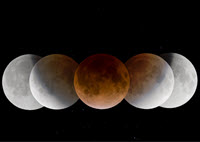
Preumbral Lunar Eclipse
(Image: Ad Astra La Palma)
There is a penumbral eclipse of the Full Moon on the 10th, however don’t get too excited as only some very slight dimming of the moon will be noticeable during the evening. Not one for the scrap books really!
Earth reaches Perihelion
Finally, on Jan 3rd Earth reaches Perihelion (closest to the Sun in its orbit) some 91.4 million miles or 147 million km distant. This usually comes as a surprise to non astronomers, who expect the Earth to be furthest from the Sun in January. As we know it’s not the distance from the Sun, which gives rise to the short, dark winter days, but the tilt of the Earth’s axis, with the northern hemisphere being tilted away.
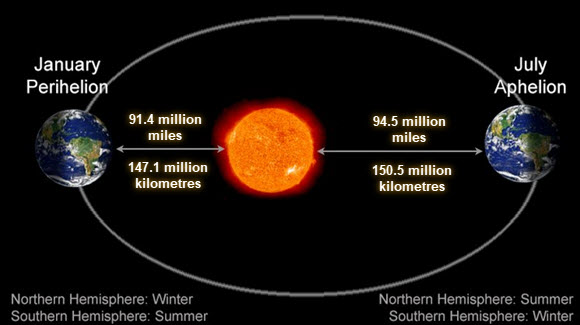
January 2020 Sky Charts
|
Looking North
Mid-January - 20:00h |
Looking South |
|
Looking East
Mid-January - 20:00h |
Looking West
Mid-January - 20:00h |
|
Northern Aspect
Mid-January - 20:00h |
Southern Aspect
Mid-January - 20:00h |
|
Looking North (Early)
Mid-January - 06:45h |
Looking South (Early)
Mid-January - 06:45h |
Additional Image Credits:
- Planets and Comets where not otherwise mentioned: NASA
- Sky Charts: Stellarium Software
- Log in to post comments

